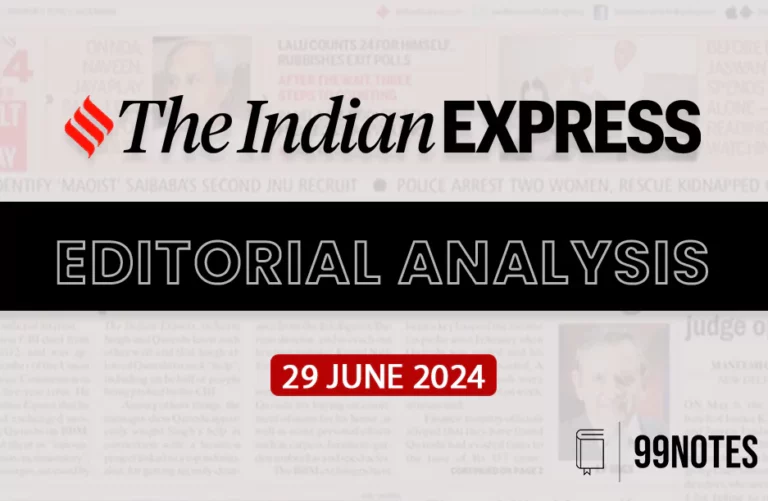10 Jan 2024 : Indian Express
Indian Express
10- January-2024
1. A note to security planners
| Topic: GS3 – Internal Security- Role of external state and non-state actors. This topic is not much relevant in the context of Prelims but more for Mains in the context of security challenges, both external and internal, provides a comprehensive understanding of contemporary security issues. |
| Context: |
|
The Dynamics of 2023: Hamas Terror Attack and Houthi Offensive:
- The article explores the events of 2023, with particular attention to Israel’s retaliation against the Hamas terror attack on October 7. This battle exposed Israeli policy and brought the Palestine problem back into the public eye.
- Additionally, the non-state group known as the Houthi rebel group in Yemen carried out a bold attack on merchant shipping that had connections to Israel, interrupting international shipping and triggering an American naval task force response.
- The article focuses on how non-state actors might present significant obstacles by utilising inexpensive technologies, such as unmanned aerial vehicles.
Common Threads: Surprises and Inadequate Preparedness
- The element of surprise in these security difficulties is a recurring topic that highlights shortcomings in tactically actionable intelligence and the capacity to predict unconventional security needs based on technological trends.
- The article cites historical incidents in India where unexpected events left security planners perplexed, including the border battle with China in 1962, the Kargil conflict in 1999, the 2008 Mumbai terror assault, and the Galwan incident in 2020.
India’s Complex Security Landscape in 2024:
- The article highlights India’s complex security issues for 2024, including those pertaining to internal security and low-intensity conflicts (LICs).
- One ongoing challenge is the strategic cooperation between China and Pakistan, as well as their support for non-state actors.
- Recent developments involving Hamas and the Huthis could give confidence to groups in the Subcontinent who have anti-Indian agendas, leading to an upsurge in terrorist action, as observed in Jammu.
Broader Regional Dynamics and Institutional Challenges
- The article discusses how developments in Myanmar, pro-China politics in the Maldives, and possible electoral dynamics in Pakistan could rekindle smouldering anti-Indian sentiment.
- India’s overall security index is expected to remain difficult in 2024 due to financial restrictions that affect military modernization and election mandates.
- Notable policy changes include the adoption of the Agniveer plan for recruits and modifications to military structure.
Future Security Planning: Adapting to Emerging Trends:
- The article’s conclusion emphasises how difficult it will be for security planners everywhere to interpret the events of 2023 and decide which traditional platforms to buy.
- Complicating matters include the changing nature of the battlefield, the advent of artificial intelligence (AI), and associated technologies.
- Security planners must test the adaptability of the next administration and higher defence management in tackling these issues by projecting scenarios involving non-state actors, covert support networks, market dynamics, and corporate power brokers.
| What can be the Potential Benefits of the National Security Strategy in India? |
|
| PYQ: The diverse nature of India as a multireligious and multi-ethnic society is not immune to the impact of radicalism which has been in her neighbourhood. Discuss along with the strategies to be adopted to counter this environment. (200 words/12.5m) (UPSC CSE (M) GS-3 2014) |
| Practice Question: Analyze the impact of recent global events, such as the Russian invasion of Ukraine and the Hamas terror attack, on India’s national security posture. Discuss how these challenges necessitate a nuanced approach in India’s strategic thinking and defense policies. (250 words/15 m) |
2. Doing justice, reinforcing trust
| Topic: GS2 – Polity- Judiciary This topic is not much relevant in the context of Prelims but more for Mains in the context of the role of the judiciary in upholding justice and the rule of law. |
| Context: |
|
Bilkis Bano’s Trauma and Legal Battle:
- Bilkis Bano, who was subjected to horrific brutality during the 2002 Gujarat riots, fought a lengthy court battle that resulted in the accused’s conviction and life sentence.
- But the contentious move by the Gujarat government to free them early on the grounds of good behaviour and time served infuriated the people and called into question the fundamentals of justice.
Premature Release and Controversial Justification
- The Gujarat government’s decision to free the prisoners in face of opposition from the CBI and a Special CBI judge begs fundamental concerns about its commitment to justice and its priorities.
- The revelation made Bilkis Bano’s suffering much worse and revealed systemic shortcomings in the way that horrific crimes are handled, in addition to offensive comments made by a former minister.
Supreme Court’s Timely Intervention:
- At this critical juncture, the Supreme Court intervenes to address public dissatisfaction with case prioritisation and apparent discrimination in the legal system.
- The ruling serves as a reminder of the independence of the court and its duty to guarantee that every person, regardless of background or type of offence, has equal access to the legal system.
Restoring Confidence in the Judiciary
- The Supreme Court has made a key move in rebuilding public trust in the justice system by ruling that the early release of the prisoners was unlawful and mandating their re-incarceration.
- Reiterating the judiciary’s dedication to the “rule of law” and setting an example for accountability, this ruling comes at a time when dissatisfaction over unfair treatment and prolonged hearings is on the rise.
Conclusion:
- In addition to sustaining justice in this specific case, the Supreme Court’s decision in the Bilkis Bano case also makes a strong statement regarding the judiciary’s duty to protect fundamental principles.
- As the country honours the judges for their bravery and dedication, it is hoped that these cases will serve as a spark for a just and equitable legal system, stopping injustice from happening again in the future.
| Legal Aspects of Remission and Release |
|
| PYQ: Starting from inventing the ‘basic structure’ doctrine, the judiciary has played a highly proactive role in ensuring that India develops into a thriving democracy. In light of the statement, evaluate the role played by judicial activism in achieving the ideals of democracy. (200 words/12.5m) (UPSC CSE (M) GS-2 2014) |
| Practice Question: Critically analyze the Supreme Court’s judgment on the premature release of convicts in the 2002 Gujarat riots case. Also, discuss the role of the judiciary in upholding the rule of law and individual rights in the context of such landmark decisions. (200 words/12.5 m) |
For Enquiry

13 Feb 2024 : Daily Current Affairs Quiz

13 Feb 2024 : Daily Answer Writing

13 Feb 2024 : Daily Current Affairs

13 February 2024 : The Hindu Editorial Notes PD

13 Feb 2024 : Indian Express Editorial Analysis

13 February 2024 : PIB Summary for UPSC

12 Feb 2024 : Daily Current Affairs Quiz

12 Feb 2024 : Daily Answer Writing

12 Feb 2024 : Daily Current Affairs

12 Feb 2024 : Indian Express Editorial Analysis
Daily Quiz 13 Feb 2024 : Daily Current Affairs Quiz 13 Feb 2024 : Daily Quiz…
mains answer writing 13 Feb 2024 : Daily Answer Writing Mains Answer Writing
13-February-2024
Q1) With the help of a map, show major ocean currents of the world….
Daily Current Affairs 13 Feb 2024 : Daily Current Affairs Daily Current Affairs
13-February-2024- Top News of the Day
1. Indian Navy Personnel Released from Custody…
Feb 2024 The Hindu 13 February 2024 : The Hindu Editorial Notes PD The Hindu Editorial
13-February-2024
1. A global alliance to bridge the gender equity gap
Topic:…
Indian Express 13 Feb 2024 : Indian Express Editorial Analysis Indian Express Editorial Analysis
13-February-2024
1. A science for us
Topic: GS2 – Governance…
feb 2024 PIB 13 February 2024 : PIB Summary for UPSC PIB Summary for UPSC
13-February -2024
1. Union Minister G Kishan Reddy inaugurate regional centre…
Daily Quiz 12 Feb 2024 : Daily Current Affairs Quiz 12 Feb 2024 : Daily Quiz…
mains answer writing 12 Feb 2024 : Daily Answer Writing Mains Answer Writing
12-February-2024
Q1) “Water scarcity threatens economic and social gains…
Daily Current Affairs 12 Feb 2024 : Daily Current Affairs Daily Current Affairs
12-February-2024- Top News of the Day
1. Great Indian Bustards give Nandyal a…
Indian Express 12 Feb 2024 : Indian Express Editorial Analysis Indian Express Editorial Analysis
12-February-2024
1. CLASSROOM VS COACHING
Topic: GS2 – Social…





